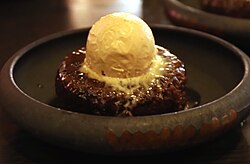English dessert
Sticky toffee pudding, known as sticky date pudding in Australia[1] and New Zealand, is a British[2] dessert consisting of a moist sponge cake made with finely chopped dates (optional), covered in a toffee sauce and often served with a vanilla custard or vanilla ice-cream.[3] It is considered a British classic by various culinary experts.[4]
Composition
A sticky toffee pudding has two essential components, sponge cake and toffee sauce. The first, is a moist sponge cake, usually containing finely chopped dates.[5] The sponge is usually light and fluffy, closer to a muffin consistency rather than a heavier traditional British sponge, and is often lightly flavoured with nuts or spices such as cloves.[5][6] The second key element, is the toffee sauce, usually made from double cream and different dark sugars (brown sugar, jaggery, molasses sugar, muscovado, panela, peen tong), depending on recipe.[6]
A sticky toffee pudding is most commonly served with custard or vanilla ice cream, the vanilla flavour of these complementing the richer flavours of the pudding.[6] It may also be served with single cream.
Development
The origins of sticky toffee pudding are disputed. Owners of several pubs, including the Gait Inn in Millington, East Riding of Yorkshire (claimed to 1907) and the Udny Arms Hotel in Newburgh, Aberdeenshire (1960s), claim to have invented it.[7]
The pudding was popularised in the 1970s by Francis Coulson and Robert Lee, who developed and served it at the Sharrow Bay Country House Hotel in Cumbria.[8][9] The food critic Simon Hopkinson said Coulson told him he received the recipe from a Patricia Martin of Claughton in Lancashire,[10] and that Martin had received it from Canadian air force officers who lodged at her hotel during the Second World War.[10][5]
A take home version to heat, either in oven or microwave, was developed in 1989 by the owners of the Village Shop in Cartmel, Cumbria.[5][11] Their dish became popular, and by the late 1990s was being sold in supermarkets across the UK.[11] The dish is now widely available from multiple manufacturers to bake at home.[12]
